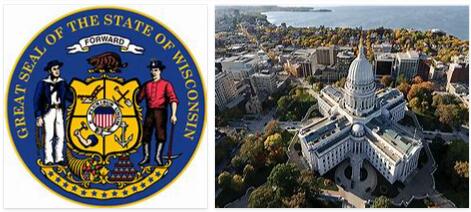Maine is a federal state of the United States (86,156 km 2 with 1,316,456 inhabitants in 2008); capital Augusta. It is the northernmost of the states of New England, bordering Canada from northwest to east The economy maintains the traditional multisectoral profile, in which agriculture plays an important role. Over 7,000 farms (cereals, potatoes, etc.) and livestock farms are spread over just under half a million hectares. Forest exploitation is very intense; fishing and aquaculture are also important. The contribution of the manufacturing sector is considerable, in particular the production of paper (over a third of the added value). The state’s per capita income is about 20% lower than the US average.
After vain attempts at French and English colonization (17th century), the territory between the Merrimac and Kennebec rivers was ceded by the New England government to Sir Ferdinand Gorges. His nephew William obtained from King Charles I(1639) a first charter of rights for Gorgeana (today’s York), the first capital of Maine. In 1677 the territory was absorbed, by purchase, by the Massachusetts, which in 1691 obtained legal recognition as “Royal province of Massachusetts Bay”, including Maine, Sagadahoc, Plymouth And Acadia. During the war of 1812, the separatist movement established itself among the settlers and Maine in 1820 became part of the Union as an independent state.
The population, which numbered 583 thousand residents in the middle of the last century (the state dates from 1820), it had 661,000 in 1890, 694,000 in 1900 and 768,000 in 1920. In 1930, those born abroad represented 12.6% of the total, for the most part (almost 3/4) British and French from Canada. There were 2359 Italians on the same date. 40.3% of the inhabitants of Maine live in centers over 2,500 inhabitants; none of these, however, touches 75,000 residents Portland, which is the most populous, had 70,810 in 1930; followed by Lewiston (35,000), Bangor (29,000), Auburn (19,000), Biddleford (17,000) and Augusta (17,000), the state capital.
According to countryaah, Maine has the following main cities:
Augusta
Capital of the state of Maine (United States) and capital of Kennebec County, located at 44 ° 20 ′ lat. N. and at 69 ° 50 ′ long. O., on the Kennebec River, which connects it by waterway to Portland and Boston. It is just over 70 km from the mouth of the river. and it is at 12 msm
The town originated in 1754 when the Plymouth Company built Fort Western. Settlers began to flow in (1762) and the small town was known as Cushnoc, from the name of an Indian village that stood nearby. The name of Augusta dates from the end of the century. XVIII. It became the state capital in 1831.
The city had 14,114 inhabitants in 1920 and 8665 in 1880; the increase from 1880 to today has therefore been 38%, far from equaling that of the great coastal centers of the Atlantic.
Portland
The most populous city in the state of Maine (United States), the capital of Cumberland County, located on Casco Bay, on a peninsula, at the mouth of the Fore River. Founded in 1632, it has become the most important port center in the extreme northeastern section of the Atlantic United States. It has a cold oceanic climate, with an average annual temperature of 7 °, 6 ° (January -5 °, 6; July 20 °), with a notable difference between absolute minimums and maximums (-27 °, 1; 36 °, 1); rainfall is abundant, equal to 1047 mm. and distributed regularly in every month of the year; considerable snowfall; the ice hinders navigation only for a short time. The city had 2240 residents in 1790, 20.815 in 1850, 50.145 in 1900, 58.571 in 1910, 69.272 in 1920, 70.810 in 1930. In this year the ethnic composition was as follows: Indigenous whites and born to foreign parents 83.1%; Whites born abroad 16.5% (in total 11,671 individuals with a prevalence of Canadians, Irish, Italians, English, Russians), color elements 0.4%. In 1930, 30,522 people over the age of 10 were employed in the various economic activities. In large industry 5338 workers worked in 1890, 4518 in 1929 (woodworking; furniture factory; preserves; steel and mechanical industries, etc.). But the great importance of Portland lies in its commercial activity: the port has a waterfront of 13.7 km. and owns 48 piers and docks, with silo facilities (capacity of approximately 110 million liters). Canadian grains pass through the port of Portland during the winter, when frost prevents navigation on the St. Lawrence River. The overall average annual traffic, for the period 1917-1926, was 2-3 million metric tons: the main foreign trade import items concern petroleum and derivatives (35%), clay of China (22%), wood pulp (21.1%) from Canada and Scandinavian countries, coal and coke (17.5%), etc. In exports, wheat and flour hold the record (86%), with an absolute prevalence of Canadian origin, but have experienced a slow decline in recent years, partly due to the increased use for winter cargo in the Canadian ports of St John and Halifax.. The city is served by numerous international shipping lines and by various railway lines.
On the opposite bank of the Fore, crossed by four bridges, is South Portland (13,840 residents In 1930).
History. – It was built by Giorgio Cleaves and Riccardo Turcker in 1633 in the peninsula which had the Indian name of Machegonne. First destroyed by the Indians in 1676, again by the Indians allied with the French in 1690, it remained desolate until the Peace of Utrecht (1713). For joining the colonial revolt against England, it was bombed by the English fleet in 1775. It was the state capital from 1820 to 1832.











